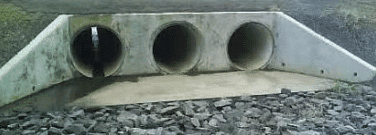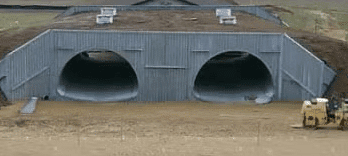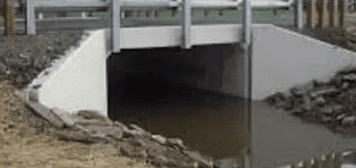Culvert Structures: Types, Loading Conditions and Materials | Civil Engineering Optional for UPSC PDF Download
| Table of contents |

|
| Culverts Overview |

|
| Culverts |

|
| Types of Culverts |

|
| Materials for Culvert Construction |

|
| Culvert Failures |

|
Culverts Overview
A culvert functions as a tunnel that allows a stream to pass beneath a road or railway, essentially serving as a bridge for transportation purposes. These structures are commonly situated in natural water flows and play a pivotal role in either acting as a bridge or controlling the flow of currents.- Due to the necessity of maintaining unhindered water movement, culverts are typically installed underneath roadways and highways.
- Culverts prove beneficial for roads by managing water flow in a controlled manner.
- The type of culvert chosen for construction is contingent upon various factors such as the site conditions, structural capacity, availability of construction materials, and other relevant considerations.
Culverts in Detail: This detailed exploration will encompass various facets related to culverts, including their types, construction materials, the diverse loads that impact culverts, and the potential failure scenarios they may encounter.
Culverts
Definition of Culverts:- Culverts are tunnel structures constructed beneath roads or railways to facilitate cross drainage or the passage of cables from one side to the other. They are entirely enclosed by earth or ground.
Types of Culverts:
- Common varieties include pipe culverts, box culverts, and arch culverts, which are frequently used under roadways and railways.
- Construction Parameters:
- Culverts are designed based on factors like hydraulic loads, water surface elevation, roadway height, and other relevant parameters.
- They are utilized to regulate the flow of water.
Structure of Culverts:
- Culverts are underground structures resembling bridges, featuring single or multiple spans with a minimum length of 3 meters for each span.
- They consist of two horizontal slabs cast monolithically with two or more vertical side walls, with a maximum span of 6 meters.
Purpose and Benefits:
- Culverts facilitate the passage of stormwater or non-perennial streams across roadways with shallow soil.
- They excel in challenging site conditions, require minimal maintenance, and boast a long service life.
- Importance of Proper Installation:
- Correct sizing, installation, and protection against erosion and abrasion are crucial for culverts.
Objectives of Culvert Construction:
- The primary goals are to reduce flooding, minimize erosion, and establish effective runoff paths.
- Placement and Functionality:
- Culverts are positioned beneath roads or railways and should run parallel to the road without requiring a separate embankment.
- They need to facilitate easy water movement and allow for the unrestricted passage of water and wildlife.
Risks and Failures:
- Culvert failures can result from various factors and may disrupt the natural flow of water upstream.
- Maintenance, environmental, and installation failures
- Functional or process failures related to capacity and volume causing soil erosion around or beneath them
- Structural or material failures causing culverts to fail due to collapse or corrosion of the materials from which they are made
Types of Culverts
Pipe Arch Culvert (Single or Multiple)
Pipe arch culverts resemble half-circle structures and are capable of managing higher water flows, provided the flow remains steady. The arch shape aids in the transportation of fishes or sewage towards the outlet since there is no obstruction at the inlet or channel bottom. These culverts can be manufactured in various sizes based on specific requirements, while also adding to the aesthetic appeal of the surroundings.

Box Culvert (Single or Multiple)
Box culverts, which are rectangular, primarily made of concrete, and reinforced, serve the purpose of draining rainwater. However, they are less effective during dry seasons. These structures can also act as passages for animals crossing railways or roads when conditions are dry. Due to their sharp corners, they are not suitable for handling high water velocities. Box culverts come in various sizes.

Arch Culvert
Arch culverts, resembling pipe arch culverts, feature an artificial floor beneath the arch. Commonly used in narrow passages, these culverts have concrete construction for both the arch and the artificial floor. While steel arch culverts are an option, they tend to be more expensive.

Bridge Culvert
Bridge culverts are typically found on canals or rivers and can also serve as road bridges for vehicles. These culverts are built on a foundation below ground level. Multiple culverts are installed in a series, with a pavement surface laid on top. Rectangular in shape, bridge culverts can function as alternatives to box culverts in cases where an artificial floor is unnecessary.

Materials for Culvert Construction
The following are the primary materials used in culvert construction:-Concrete
Concrete culverts are widely used in both rural and urban settings. They can be either reinforced or unreinforced. Sometimes, culverts are constructed on-site, known as cast in situ culverts, while precast culverts are also available. Concrete's strength and durability result in several advantages:
- Concrete culverts reduce installation time.
- They have a lower environmental impact compared to other materials.
- Concrete culverts lead to increased cost savings.
Steel
Steel plays a significant role in culvert construction, particularly Structural Steel Plate (SSP) and Corrugated Steel Pipe (CSP):
Arch culverts and metal box culverts are typically constructed using structural steel plate. SSP is more corrosion-resistant and stronger than standard carbon steel, ensuring longevity. It meets the criteria for a durable culvert. The CSP, on the other hand, is utilized in round pipe culverts, offering strength and flexibility. These culverts do not deform under load due to their robustness. Various shapes and options in corrugated steel pipe products cater to specific requirements.
Aluminium Culvert Pipes
Aluminium culvert pipes can be manufactured using structural plates or a single piece of aluminium. This material is predominantly utilized in constructing metal box culverts due to its beneficial properties:
- Lightweight
- Ductility
- Recyclability
- Corrosion Resistance
Benefits of Aluminium Pipes
- Lightweight: Aluminium pipes are known for their lightness, making them easy to handle and transport.
- Ductility: They possess the quality of ductility, allowing them to deform without breaking under stress.
- Recyclability: Aluminium is recyclable, contributing to environmental sustainability by reducing waste.
- Corrosion Resistance: These pipes exhibit excellent resistance to corrosion, ensuring durability in various environments.
High-Density Polyethylene (HDPE)
High-Density Polyethylene (HDPE) is favored for its exceptional strength-to-weight ratio, particularly in gravity flow systems due to meeting specific standards and project requirements:
- Lightweight but extremely strong
- More impact resistance
- Weatherproof and long-lasting
- Resistance to insects and ideal for underground water delivery
- Easily formed into almost any shape
Advantages of HDPE
- Lightweight but extremely strong: HDPE combines strength with a lightweight nature, ensuring structural integrity without added bulk.
- More impact resistance: It can withstand impacts, making it suitable for various environmental conditions.
- Weatherproof and long-lasting: HDPE's durability ensures longevity even in harsh weather conditions.
- Resistance to insects and excellent for underground water delivery: It is impervious to pests and well-suited for conveying water underground.
- Easily formed into almost any shape: HDPE's flexibility allows it to be molded into diverse configurations, enhancing its utility in construction projects.
Location of Culverts
- Culverts should be positioned based on cost-effectiveness and utilization. It is typically advised that culverts be placed beneath roads or railways, eliminating the necessity for a separate embankment.
- The culverts must run perpendicular to the roadway, featuring larger dimensions to accommodate high water levels and should be situated to facilitate straightforward flow, achievable by ensuring the required gradient.
Loads Acting on Culverts
- Various types of loads affect culverts, as outlined below:
- Live loads: These loads are movable or dynamic, such as vehicles or pedestrians crossing the culvert.
- Dead loads: These are static loads like the weight of the culvert itself and the soil above it.
- Environmental loads: Factors like soil pressure, water pressure, and frost action exert forces on the culvert.
- Surcharge loads: Additional loads from sources like construction equipment or stored materials can impact the culvert's stability.
Understanding Culvert Loads
- Dead Load: Dead load encompasses the inherent weight of all culvert components, including the wearing course, crash barrier, and fixed loads.
- Earth Pressure Load: This load involves horizontal soil pressure acting on vertical walls. Weep holes facilitate pore pressure release in culverts. In deep culverts, a uniform vertical surcharge is applied to the top slab.
- Traffic Loads: Culverts endure moving traffic loads throughout their lifespan. It's crucial to apply traffic loads in adherence to global codes for culverts and bridges.
- Buoyant Force: Buoyant force results in an upward thrust due to buoyancy, which can uplift and displace culverts in strong water currents. Culvert weight must resist this uplift.
- Temperature Loads: Temperature stresses arise from the expansion and contraction of structures like culverts due to temperature fluctuations. There are two types: uniform temperature stresses from consistent heating and cooling, and gradient temperature stresses from differential member heating and cooling along the structure.
Additional Considerations
- Dynamic loads are also factored when rail tracks are placed on top of culverts.
Culvert Failures
Steel Failures:
- Steel culverts deteriorate due to lack of maintenance, primarily from corrosion.
- To mitigate this, designers often increase pipe thickness beyond standard requirements.
Erosion-Induced Failures:
- Erosion around culverts can lead to structural settlement and subsequent collapse.
Settlement Issues:
- Improper ground assessment during design can result in excessive settlement.
- Excessive settlement in arch structures can cause material separation and system failure.
Excessive Loads:
- Incorrect load estimation during design and vehicle movements can lead to failure.
Understanding the vulnerabilities of culverts is crucial for civil engineering exams and technical recruitments. By grasping these failure modes, you can enhance your preparation and excel in your field.
|
352 videos|468 docs|2 tests
|
FAQs on Culvert Structures: Types, Loading Conditions and Materials - Civil Engineering Optional for UPSC
| 1. What are the different types of culverts? |  |
| 2. What materials are commonly used for culvert construction? |  |
| 3. What are some common culvert failures? |  |
| 4. What are the different loading conditions that culvert structures are subjected to? |  |
| 5. How does the choice of material affect the performance of a culvert structure? |  |














